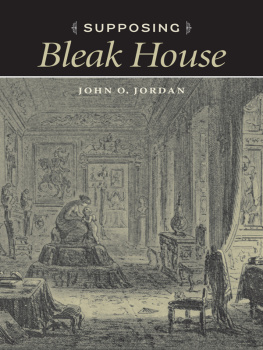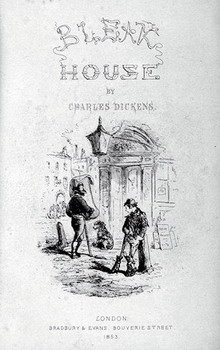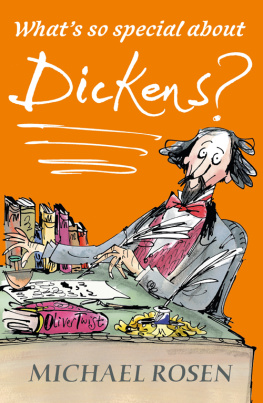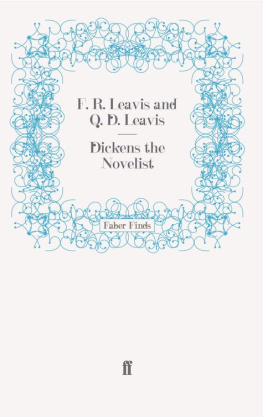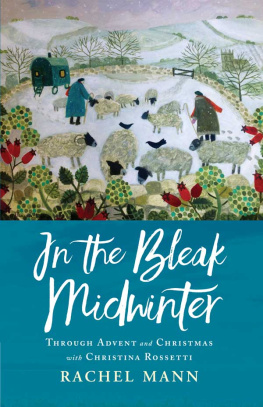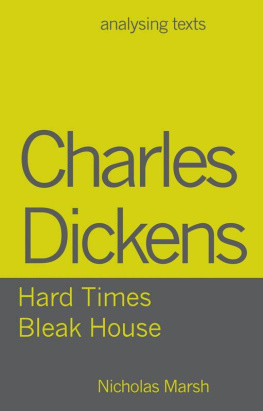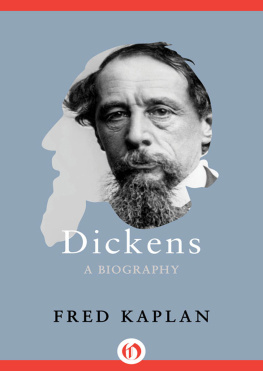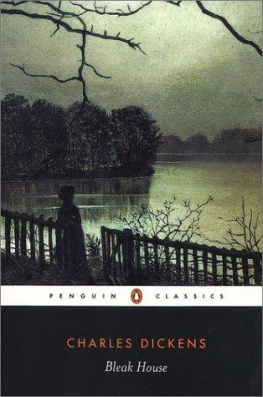Jordan, John O.
Supposing Bleak House / John O. Jordan.
p. cm.(Victorian literature and culture series)
Includes bibliographical references and index.
ISBN 978-0-8139-3074-9 (acid-free paper)ISBN 978-0-8139-3092-3 (e-book)
1. Dickens, Charles, 18121870. Bleak House. I. Title.
PR4556.J67 2010
823.8dc22
Unless otherwise noted, all illustrations are by Hablot K. Browne, etchings from original serial parts of Bleak House, 185253. (Courtesy of the Department of Special Collections, Stanford University Libraries)
ACKNOWLEDGMENTS
LONG CONTEMPLATED, THIS BOOK WOULD NOT ALLOW ITSELF to be written until it was ready. When the time came, it offered itself with unstinting generosity. Lengthy incubation in this case entails great indebtedness. I owe thanks in the first instance to Murray Baumgarten and Ed Eigner, who brought me along when they had the idea of starting a Dickens research group at the University of California. To Murray in particular, the Dickens Project's founding director and my longtime co-conspirator in all things Dickensian, I owe a debt of gratitude for colleagueship that extends over four decades and that includes many conversations about Bleak House.
An early version of was presented at the 2001 Dickens Universe gathering in Santa Cruz. I am grateful to friends, students, and colleagues for their positive response on that occasion and to delegates at the 2009 Uneasy Pleasures conference in Jerusalem, where I presented a later version of this chapter. The book's appendix appeared in the March 2010 issue of Dickens Quarterly and is reprinted here with the kind permission of the journal's editor, David Paroissien.
To Bob Newsom and Hilary Schor, two passionate, expert readers of Bleak House, I owe special thanks for their long friendship and for innumerable exchanges about Esther and about Dickens. So many of the ideas that appear in these pages first took shape in conversations between the three of us that it is sometimes difficult for me to know to whom they properly belong, though of course I bear ultimate responsibility for the words on the page. Bob read the entire manuscript, offered many useful suggestions, and was especially helpful in sharpening my understanding of the novel's illustrations.
Others who read the manuscript and provided useful advice include Bob Patten, who took valuable time away from his own research to check first editions of the novel at the Rice University library; Dick Stein, whose encouragement came at a crucial moment; Lou Breger and Jon Varese, each of whom saved me from embarrassing mistakes; and Tim Peltason, whose detailed comments helped improve my argument at several points. Helen Hauser provided important research assistance in London. Lunch conversations with Michael Warren, Gary Miles, and Galia Benziman advanced my work in ways of which they may not be fully aware.
A series of informal study sessions with JoAnn and Greg Bellow proved valuable in developing my ideas about psychoanalysis. Even when Greg and I disagreedespecially when we disagreedour exchanges forced me to clarify my thinking and look for further evidence to explain what I was trying to say. The book is better as a result of our dialogue. At a later stage, Estelle Shane gave me incisive comments on some of the psychoanalytic ideas I was trying to work out.
Without the assistance of libraries and librarians, this project would have been impossible to complete. I am grateful to the staff of McHenry Library at the University of California, Santa Cruz, for timely help in processing interlibrary loan requests. For assistance in locating illustrations and for granting permission to reproduce them, I thank John Mustain and Mattie Taormina at the Stanford University Libraries, Katharine Chandler and Joseph Shemtov at the Free Library of Philadelphia, Moira Fitzgerald at the Beinecke Rare Book and Manuscript Library, Yale University, and David Marshall of Duckworth Publishers. At several points my research has been supported by grants from the Academic Senate Committee on Research at the University of California, Santa Cruz. I appreciate the committee's confidence in my work.
The memory of two people who will never know how much I owe to them looms large in the background of this book. One is my mother, Mary Hamilton Thompson Orr Jordan, whose presence can be felt on almost every page. The other is Sally Ledger, whose untimely death in early 2009, just as a draft of this book was nearing completion, left a large hole in the community of nineteenth-century scholars of which I am a part. The importance for me of Sally's work on Dickens is especially evident in .
To JoAnna Rottke, the Dickens Project's incomparable coordinator, and to Jay Olson, computing assistant at UC Santa Cruz, I am grateful for help in preparing the manuscript for publication. To Cathie Brettschneider at the University of Virginia Press, I am thankful for many courtesies, for her patience in answering questions, and for her faith in this project. Thanks go as well to Colleen Romick Clark, herself a Victorianist, for her supportive and sharp-eyed copyediting.
My greatest debt is to my wife, Jane, who shares her life with me and from whom I have absorbed much that is in this book. Her love and confidence in me made it possible for Supposing Bleak House to be written.
1
VOICE
I TOO HAVE A GREAT DEAL OF DIFFICULTY IN BEGINNING TO write my portion of these pages. I know that I find Bleak House to be the most powerful of all of Dickens's novels, and yet I fear that I will never be able to explain adequately to anyone else or to myself why it exerts such a strong hold over me. I know that I have been reading Bleak House for nearly forty years and that each time I reach the point where Esther discovers what she has not quite yet allowed herself to realize is her mother's body lying outside the miserable graveyard, each time she lifts the heavy head, puts the long dank hair aside, turns the face, and recognizes that it was my mother, cold and dead, I weep. I weep in part because this scene vividly evokes the memory of my own mother's death. I weep also because the words of disavowal that Esther uses to fend off the terrible knowledgecalling the female figure before her the mother of the dead child, words at once mistaken and yet truer than she knowsthese words resonate closely with certain crucial facts of my mother's life (and hence of my own), the loss of her first-born child (my older brother) at the age of two and a half, and her death thirty-six years later only one day before the anniversary of that great sadness.
I weep in addition, of course, because the simple and yet chilling words with which chapter 59 comes to a close are so magnificently orchestrated, the narrative voice so powerful and pure. Dickens, or rather Estherfor it is to her that I wish to credit the writing in this and the other chapters that she narratesslows down the action of discovery into its component parts, each within a separate clause, forcing the reader to experience syntactically the recognition that she at once resists and, unconsciously and in retrospect, knows to be inevitable. After so many chapters, and so many words, the stark monosyllableslong dank hair, turned the face, cold and deadstrike with unusual force. One of the finest things in all of Dickens, this chapter ending (which also ends the penultimate monthly number) is the thematic and emotional climax of the novel. It not only brings to an end the hallucinatory chase sequence involving Esther and Detective Bucket that occupies most of monthly numbers 17 and 18; it also provides closure of a sort to three important and related strands in Esther's inner journey: her quest for a stable, coherent self, for reunion with her mother, and for understanding of the mystery of her origins. What it does for her as narrator, what it omits and leaves unresolved, I shall have more to say about later in this essay.

